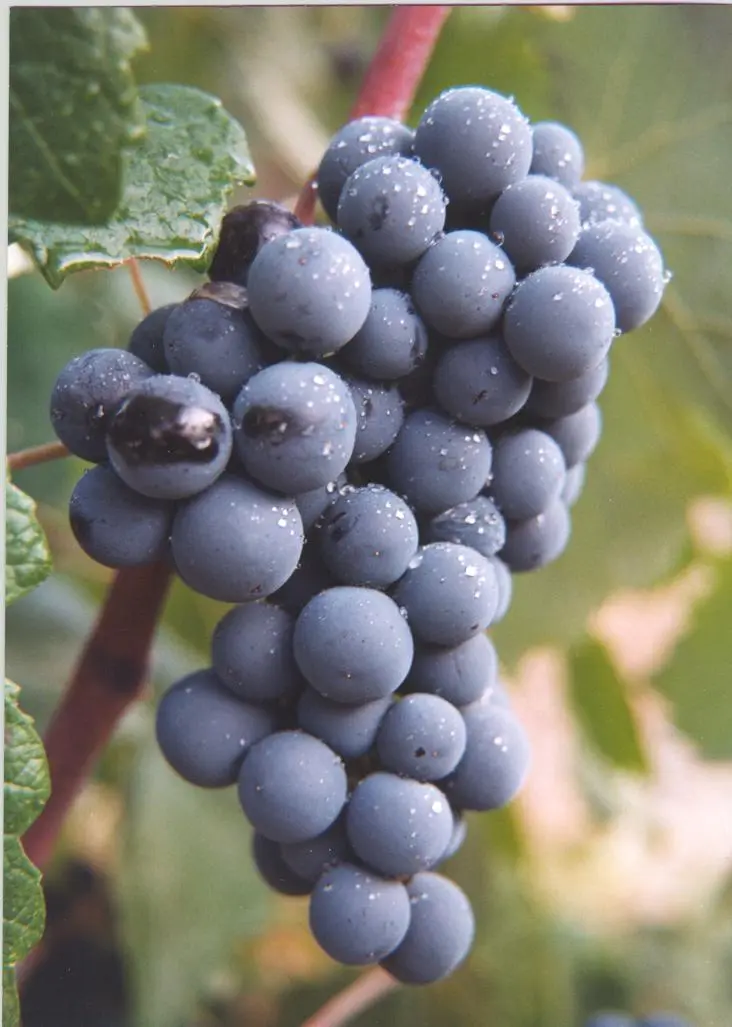Bobal: Spain’s Wild Red Underdog
You won’t find Bobal in most tourist tastings or glossy Rioja lineups, but ask around Valencia or anywhere natural wine nerds gather and this inky, high-acid red gets reverent nods. Long dismissed as rustic, rough, or relegated to bulk wine blends, Bobal is finally getting the attention it deserves — not because it’s polished, but because it’s wild, raw, and entirely itself.
Grown mostly in Utiel-Requena, where old bush vines cling to rocky soils under intense sun and cooling winds, Bobal is a wine of place and patience. It can be youthful and juicy, or age into something deep and chewy. It’s the kind of wine you want around a campfire, with grilled sausages and a lack of pretense. And while it may not be Spain’s most famous grape, it might just be one of its most exciting.
Bobal Fast Facts
Also known as: Not much! Bobal is pretty much Bobal wherever it goes — this grape flies under the radar.
Pronunciation: boh-BAHL
Colour: Red (tinto), though there’s a rare rosado version too
Body: Medium to full-bodied
Tannins: Firm, sometimes rustic, especially in traditional styles
Acidity: Moderate to high — fresh enough to handle the Spanish sun
Alcohol: Typically 13–14.5%
Flavour profile: Blackberry, black cherry, dried plum, cocoa, licorice, herbs, and sometimes a dusty or earthy finish
Texture: Often grippy, but modern styles are getting silkier — especially with oak or amphorae
Best regions in Spain: Utiel-Requena (Valencia), Manchuela (Castilla-La Mancha), Ribera del Júcar
Ageing potential: Good — especially old-vine, low-yield wines. Expect 5–10 years of graceful ageing with the right producer.
Food pairings: Chargrilled meats, wild mushrooms, hearty veggie stews, rustic sausages, Manchego cheese
Price range: One of the best value-for-money grapes in Spain. Great bottles for €8–15, and some stunning old-vine examples at €20–35
Production notes: Often grown as bush vines in high-altitude vineyards. Naturally disease-resistant and drought-hardy.
Fun fact: Despite its low profile, Bobal is actually Spain’s third most planted red grape — behind Tempranillo and Garnacha. It’s the underdog that deserves more love.
What is Bobal?
Bobal is a thick-skinned, late-ripening red grape grown almost exclusively in eastern Spain — mostly in Utiel-Requena, a region inland from Valencia that most wine tourists blast past on their way to the beach. For decades, Bobal was treated as a workhorse grape: big yields, deep colour, tons of acidity. It was used for blending, for bulk wine, for boxed wine, and basically anything that didn’t deserve a name on the label.
But things change. And Bobal is changing.
When grown with care — especially on old bush vines at higher altitudes — Bobal shows serious potential. It can produce wines that are juicy but structured, dark but not heavy, fresh but wild. It’s not trying to be smooth and silky like Tempranillo or Grenache. It’s trying to be Bobal — rugged, high-acid, sometimes herbal or earthy, always unapologetically Spanish.
The name “Bobal” is thought to come from the Latin word bovale, meaning bull — either because the grape bunches are big and round like a bull’s head, or because this thing doesn’t mess around. Either way, it’s fitting.
This is a grape that, until recently, barely got mentioned outside of co-op blending tanks. Now? It’s the flagship of a regional revival, with producers championing Bobal as the future of eastern Spain’s wine identity. And drinkers are catching on.
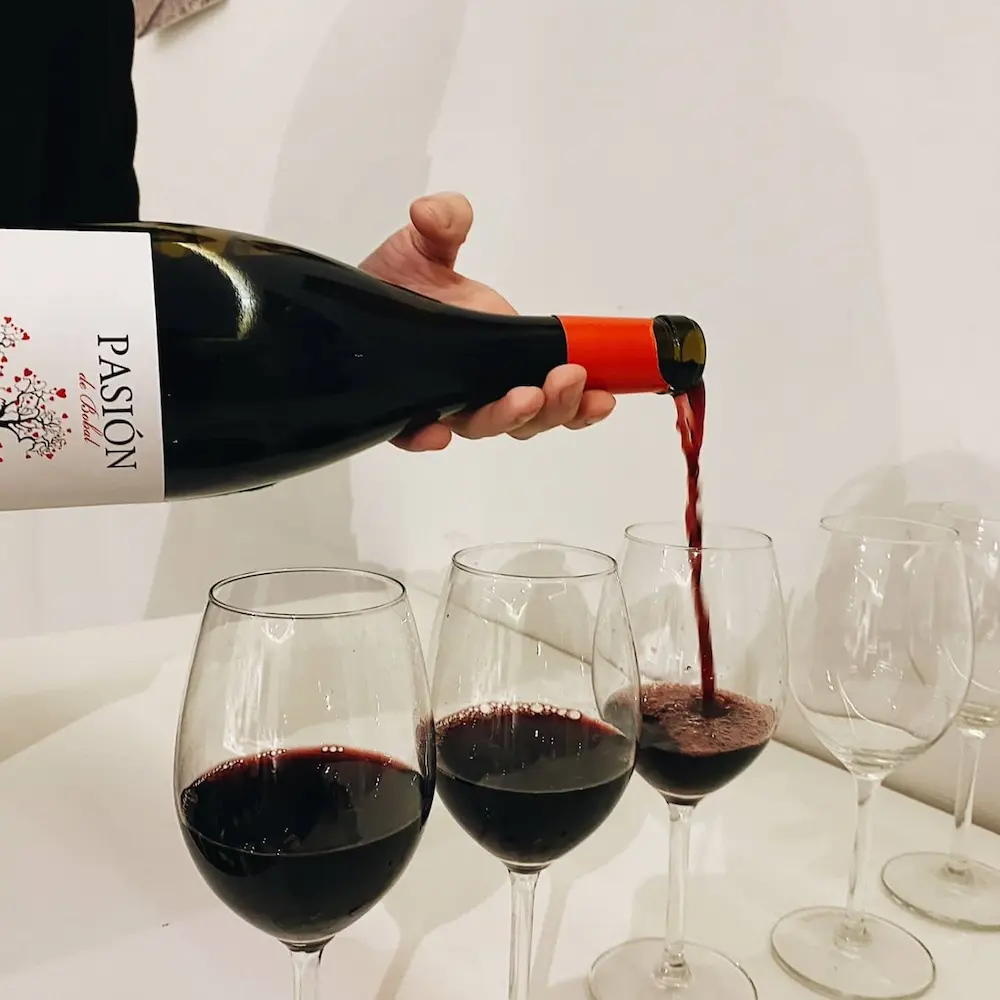
How to Identify a Bobal
You don’t need to be a wine snob to spot a Bobal. It practically announces itself the moment it hits the glass — and especially once it hits your tongue.
What does Bobal look like?
Inky. Deep purple. The kind of colour that makes your teeth nervous. Bobal is naturally high in anthocyanins (those pigments that stain your glass, lips, and dignity), so expect a dense, vibrant hue, even in younger or unoaked styles.
If someone hands you a glass of “light red” Bobal, you’re either dealing with a chillable natural take or someone who’s lying.
What does Bobal feel like in your mouth?
Juicy. Tart. Sometimes grippy. The acidity is high — that’s part of what’s kept it relevant in Spain’s hotter interior — and the tannins can range from soft and sappy to rustic and mouth-drying, depending on the winemaking.
In young, natural versions, it’s lively and nervy — like a sour cherry with a kick of rosemary. In older, oaked versions, you’ll feel more structure and weight, but rarely heaviness.
What does Bobal smell like?
-
Primary aromas: blackberries, sour cherries, red plums
-
Secondary: dried herbs, wildflowers, sometimes a hint of cocoa or black tea
-
Occasionally: earthy funk, balsamic, or even a whiff of iron — especially in natural bottlings
It’s not perfume-y or elegant like Garnacha. It’s honest. Sometimes wild. Often delicious.
Alcohol Level of Bobal
Despite growing in some seriously hot areas, Bobal doesn’t often spiral into big-booze territory. It’s surprisingly moderate in alcohol — typically around 12.5–13.5%, though modern styles can creep toward 14%. This balance of low alcohol and high acidity makes it a bit of a unicorn in Spanish reds: refreshing, serious, and actually food-friendly.
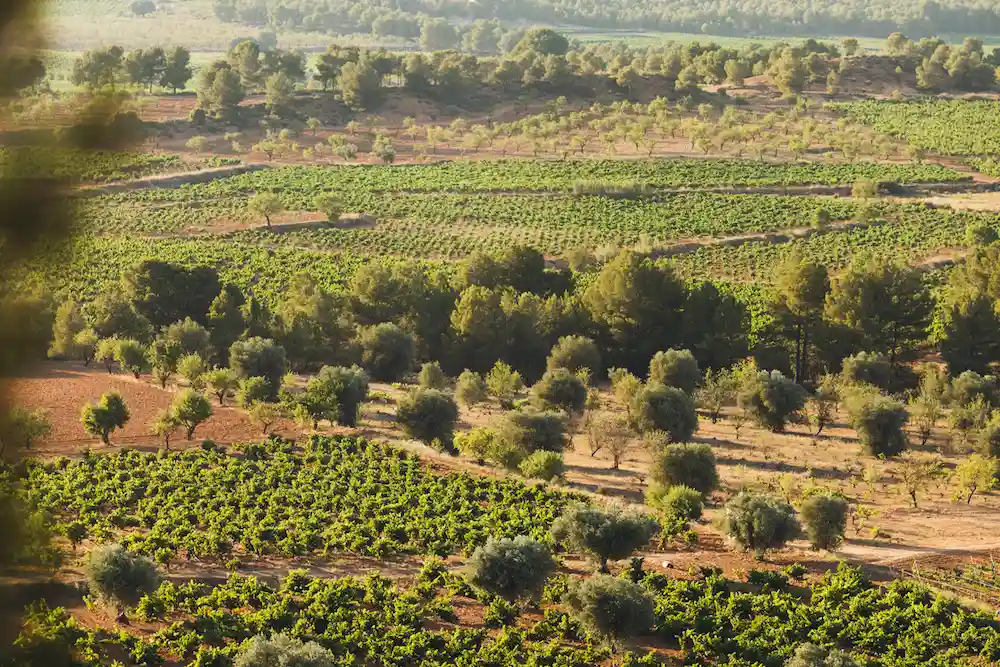
Where Does Bobal Grow?
Bobal is intrinsically linked to Utiel-Requena, a Denominación de Origen Protegida (DOP) nestled in the province of Valencia, eastern Spain. This region, characterized by its high-altitude vineyards ranging from 600 to 900 meters above sea level, offers a unique combination of continental and Mediterranean climates. The soils here are predominantly dark, lime-rich, and low in organic matter, providing an ideal environment for Bobal vines to thrive .
Beyond Utiel-Requena, Bobal is also cultivated in neighboring areas such as Manchuela, Valencia, and parts of Castilla-La Mancha. Each of these regions imparts distinct characteristics to the grape, influenced by variations in altitude, soil composition, and microclimates.
The 2024 Floods: A Turning Point for Bobal
In late October 2024, the Utiel-Requena region experienced one of its most devastating natural disasters in recent history. A weather phenomenon known as a “DANA” (Depresión Aislada en Niveles Altos) unleashed torrential rains, leading to catastrophic flooding. The deluge resulted in the loss of over 200 lives and caused extensive damage to infrastructure and agriculture .
For the Bobal vineyards, the timing was both fortunate and unfortunate. The majority of the grape harvest had been completed prior to the floods, sparing the 2024 vintage from significant damage. However, the vineyards themselves did not escape unscathed. Floodwaters uprooted thousands of vines, eroded topsoil, and destroyed irrigation systems. In some areas, entire fields were submerged, and the force of the water left behind debris ranging from rocks to household appliances .
The long-term implications for Bobal production are still unfolding. Concerns have been raised about potential fungal diseases due to prolonged moisture and the structural integrity of the vineyards. Additionally, the economic impact on local growers is profound, with many facing the daunting task of replanting and restoring their lands.
Despite these challenges, the resilience of the Utiel-Requena wine community shines through. Efforts are underway to rehabilitate the affected areas, and there is a collective determination to ensure that Bobal continues to flourish in its ancestral home.
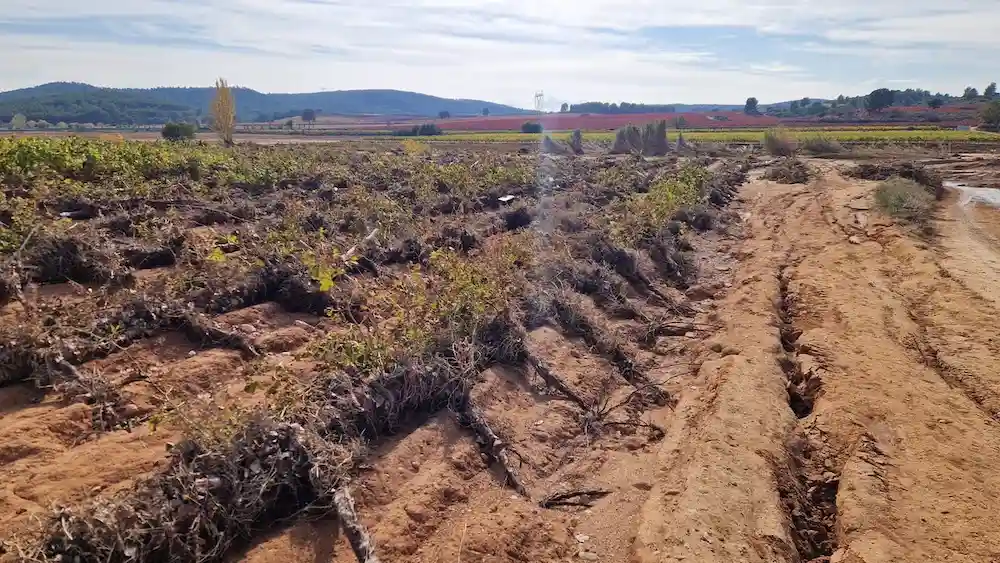
What Kind of Wine Is Bobal?
Bobal used to be the wine your grandad drank out of a jug with lunch. Now it’s being poured in natural wine bars in Paris and pop-ups in Melbourne. That’s the shift — and it all comes down to how winemakers are treating it.
From bulk wine to boutique bottles
Historically, Bobal was mass-produced, vinified in big cement tanks or steel vats, and sold cheaply — its deep colour and acidity making it ideal for blending. These wines were rough, rustic, and rarely left the region. But as old vines were rediscovered and growers started caring more about quality than quantity, everything changed.
Today, Bobal comes in multiple personalities:
Fresh & Juicy (Minimal Intervention Style)
-
Made with native yeasts, often unfiltered or only lightly sulphured.
-
Short maceration, aged in steel or concrete.
-
Bright, crunchy, herbal, and best served slightly chilled.
-
These are the bottles popping up in natural wine bars and weekend markets.
-
Think producers like Ponce (Manchuela).
Structured & Serious (Modern & Polished Style)
-
Grapes from old vines, low yields, longer maceration, and careful oak ageing (often in large foudres or neutral barrels).
-
These wines are inky, balanced, age-worthy, with deep fruit, grippy tannins, and spice.
-
Aimed more at the serious wine drinker who still wants acidity and place — not polished blandness.
-
Think Bodegas Mustiguillo.
Natural Wine Vibes (The Wild Side)
-
Some Bobal wines are completely off the leash: no SO2, long skin contact, fermented in amphora, bottled cloudy, and full of personality.
-
Expect lifted acidity, wild herbs, maybe some VA, and lots of soul.
-
More hit-or-miss depending on your palate, but when they hit? Electric.
Rosado and Sparkling?
Yep. Bobal’s acidity makes it a solid candidate for rosé, especially in local styles from Utiel-Requena. You’ll find dry, zingy rosados made from saignée or direct press, often with raspberry and herbal notes.
There’s even the occasional ancestral method pét-nat floating around — usually from the new wave of experimental winemakers.
In short: Bobal isn’t just one thing. It can be chuggable or contemplative, chillable or cellarable, and if you’re into acidity, energy, and wines that taste like where they came from, you’re probably going to like where Bobal’s going.
How to Serve and Pair Bobal
Bobal’s a food wine — and a surprisingly flexible one at that. With its zingy acidity, deep fruit, and earthy backbone, it pairs best with dishes that are rustic, hearty, herby, or just slightly messy. You won’t often find Bobal in a white-tablecloth situation… and honestly, that’s part of its charm.
How to Serve Bobal
-
Temperature:
Serve young or natural styles slightly chilled — around 12–14°C. These are your juicy, picnic-friendly Bobals.
Oaked or structured bottles? Let them breathe at 16–18°C. Give them a little air and they’ll give you a lot back. -
Decanting:
For anything older or aged: yes, please. Even 20 minutes in a jug makes a difference. Expect some sediment in low-intervention styles — that’s your rustic reminder it came from a place, not a factory. -
Glassware:
Big enough to swirl, open enough to smell the herbs and bramble fruit. If you’re drinking a chillable one in a tumbler next to a barbecue, you’re doing it right.
What to Eat With Bobal
Bobal pairs best with food that isn’t shy — salty, charred, umami-rich, or spiced. Here’s where it shines:
Grilled Meats & BBQ
-
Lamb chops with rosemary
-
Chorizo and other spicy sausages
-
Smoky pork ribs or anything with charred fat
-
Rabbit with garlic (conejo al ajillo)
-
Paella de montaña (rabbit, snails, and rosemary)
Stews & Braises
-
Olla podrida, fabada, or any bean-heavy stew
-
Braised beef or oxtail
-
Goat or lamb tagine with dried fruit and spice
-
Lentil stews with smoked paprika
Vegetarian Options (Bobal loves umami)
-
Grilled eggplant or zucchini with miso or balsamic
-
Mushroom risotto or wild mushroom toast
-
Roasted red peppers, caramelised onions
-
Chickpea stew with spinach and smoked spices
Cheese & Snacks
-
Manchego, aged Mahón, or semi-hard goat cheeses
-
Jamón or caña de lomo
-
Smoked almonds, olives, oily tinned fish (yes)
-
Rustic bread with tomato and anchovies (pa amb tomàquet + attitude)
Pro tip: If you’re planning a backyard dinner where the food goes from grill to table and the conversation goes from laughs to politics, bring a bottle of Bobal. It’s a red that keeps up.
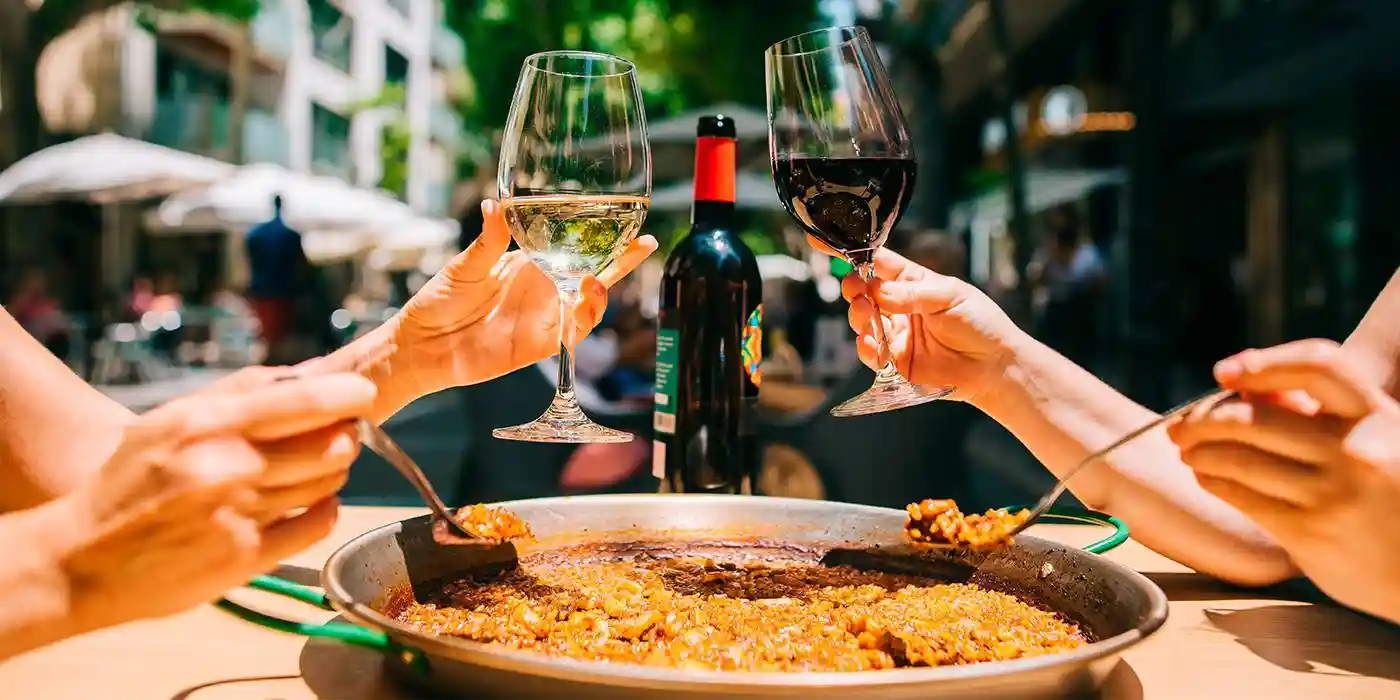
Notable Bobal Producers (And a Few Myths to Bust While We’re At It)
For decades, Bobal was the grape winemakers inherited, not the one they bragged about. But that’s changing. These days, some of Spain’s most exciting producers — especially in Utiel-Requena and Manchuela — are taking Bobal seriously, and the results are worth hunting down.
Here are some names to know, and a few misconceptions to forget while you’re at it:
Bodegas Mustiguillo (Finca Terrerazo, El Terrerazo DO)
The game-changer. Mustiguillo was the first to bottle high-quality, single-estate Bobal and take it to the world stage. Wines like Finca Terrerazo and Quincha Corral show just how complex, elegant, and cellar-worthy Bobal can be.
Myth #1: “Bobal can’t make fine wine.”
Wrong. It just needed someone to believe in it — and invest the time, barrels, and effort.
Bodegas Ponce (Manchuela)
Natural-leaning, expressive, and energetic. Juan Antonio Ponce was one of the first to treat Bobal like a serious grape for minimal intervention wines. Try La Casilla or Clos Lojen — they’re vibrant, floral, and wildly drinkable.
Myth #2: “Bobal is heavy and rustic.”
Not always. Ponce proves Bobal can be light on its feet and full of nuance.
Dominio de la Vega (Utiel-Requena)
A producer doing everything from sparkling rosé to structured reds. They make Bobal approachable without dumbing it down — perfect if you’re Bobal-curious but not ready to dive into a cloudy natty bottle just yet.
Myth #3: “Bobal is only good in red.”
Not true — its high acidity makes it an excellent base for rosado and even sparkling styles.
Bodegas Volver (La Mancha)
A modern, polished take on Bobal. Clean, bold, internationally styled wines that show the grape’s power and colour. Not necessarily terroir-driven, but a good gateway for drinkers coming from Syrah or Cab.
Myth #4: “Bobal is too weird to enjoy.”
If you like structured, fruity reds — you’ll like Bobal. Especially when it’s this well-behaved.
Altolandon (Manchuela)
High-altitude, certified organic, with a foot in the natural wine camp. Their wines are fruit-forward, fresh, and often low in alcohol, showing off Bobal’s more elegant side.
Myth #5: “Bobal doesn’t age well.”
Old-vine Bobal with structure and acidity? Absolutely age-worthy — and cheaper than its Rioja cousins.
Final word? Bobal was never the problem. The way it was grown, made, and marketed was. Now that winemakers are treating it with respect, it’s emerging as one of Spain’s most exciting reds — raw, honest, high in energy, and finally getting the love it deserves.

